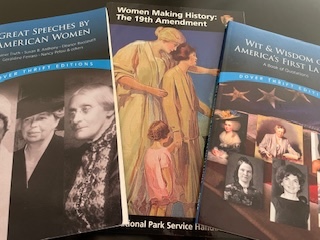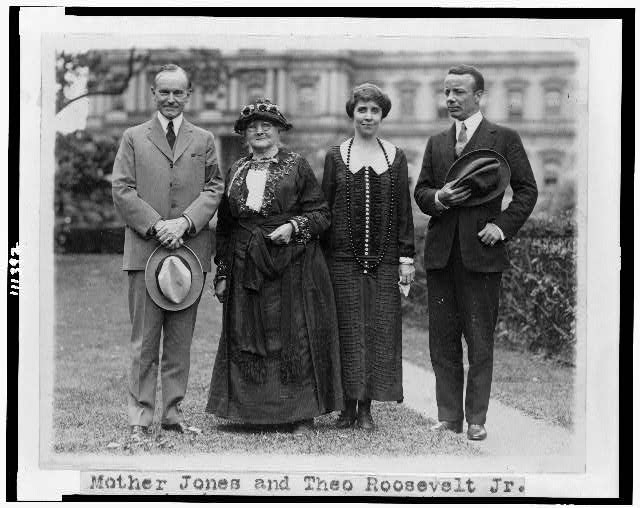What would Titian do? With six of his paintings now on view at the Isabella Stewart Gardner Museum in Boston, a bruhaha has arisen about how they should be presented to a contemporary audience. This leads me to wonder what Titian would do if he were among us today.
Would he laugh at the view, expressed by Holland Cotter in the New York Times, that the museum has a moral obligation to call attention to the “unbeautiful” aspects of the ancient Roman myths depicted in the paintings? Would he curse the Gardner’s decision to do just that, thereby initiating a skirmish in the culture wars, according to Franklin Einspruch writing for Arts Fuse? Might he revel in the controversy? Maybe he would thank Sebastian Smee for writing, in the Washington Post, that this is the art event of the decade, without acknowledging any controversy at all. Would he yawn to read in the Boston Globe that Covid complicated and delayed the show’s opening?
Before getting to what Titian would do today, let’s look at what he actually did.
When Titian was introduced to young Prince Philip, son of Charles V, King of Spain, in 1548, he was already one of the most celebrated painters of his age. He flattered the prince with a portrait, just as the young man was on the cusp of inheriting his father’s title, one that would make him ruler of most of Europe, conqueror of some of the Americas and, through marriage to co-religionist Mary Tudor of England, defender of the Catholic faith. The artist and the prince discussed a cycle of paintings to celebrate Philip’s ascendancy and Titian proposed a depiction of ancient Roman myths as told by Ovid in the Metamorphoses.

Titian created six paintings between 1553 and 1562 and sent them to Madrid where they were displayed in one of the royal residences, before being dispersed among several European collections. In 1896, Isabella Stewart Gardner acquired The Rape of Europa from a debt-ridden English earl and installed it in the drawing room of her Beacon Street brownstone, later in her Venetian-styled museum. In the current museum show, Europa is displayed with the rest of the cycle, reunited for the first time in more than four hundred years.
It is a glorious reunion, but the Gardner Museum felt the need to “contextualize” it, given the plentitude of female flesh and the scenes of violence against women. For example, the Gardner’s own painting shows Jupiter, disguised as a bull, abducting Europa and carrying her over the sea to Crete where she will be forcibly impregnated. In another, Callisto, also raped by Jupiter, has become pregnant; when the goddess Diana discovers the nymph’s condition, she banishes Callisto from the group. One painting shows Andromeda, who has offended the gods, wrapped in chains and threatened by a sea monster. In still another, Danaë, the future mother of Perseus, reclines as Jupiter descends upon her in a shower of gold.
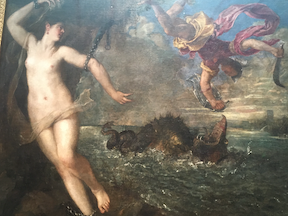
In Titian’s hands, the women show a range of expression, from horror to pleasurable anticipation to vindictiveness. Quite understandably, Europa is horrified to be carried off by a bull. On the other hand, Andromeda displays a surprising sang-froid, despite being chained at the arms and ankles; apparently she has faith that Perseus, descending from the sky, will slay the sea monster at her feet and become her husband. Danaë, in my estimation, has a lusty feel for the imminent encounter with Jupiter. When Venus clutches Adonis, to keep him in the tryst that she initiated, she’s making her desire known. And the goddess Diana not only encourages her nymphs to shame the pregnant Callisto but, in an adjacent painting, punishes the hunter Acteon when he accidentally stumbles upon her and her nymphs in the bath, knowing that he will die as a result.
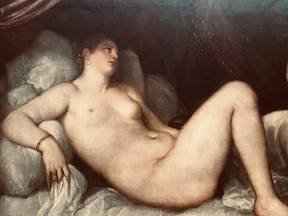
Women are indeed abused by the gods, particularly by Jupiter. To offset any impression that the museum approves of abuse, it asked contemporary artists to create two new pieces in response to Titian’s work. One (by Barbara Kruger) is a fragment of the Diana and Acteon painting – a hairy male leg atop a smooth-skinned female leg, enlarged into a poster that hangs on the museum’s outside wall. What artistic sensibility went into the poster’s making? It’s hard to discern any. The other new work is a film of a young woman (Mary Reid Kelley, filmed by husband Patrick Kelley) acting the part of Europa spouting limericks. Utterly banal, it goes on for nine tedious minutes.
The museum also partnered with the Boston Area Rape Crisis Center to provide notes for viewers. Rape is a serious crime and the BARCC provides a crucial service, but when its notes are mixed with comments from various art historians on the meaning of Titian’s work today, along with the commissioned works mentioned above, it all becomes a jumbled distraction. But these are the hoops the museum thought it must jump through in order to showcase The Rape of Europa, one of the most outstanding pieces in its collection, together with its companion paintings.
So what would Titian do? I think not much, other than be amused. He was comfortable with men as rulers of empires; invoking stories of ancient gods in order to pander to a young prince ascending to the throne was a career enhancing move for an artist. Nor was Titian a stranger to sex. He is said to have used prostitutes as his models, and to have slept with them. This does not mean that he condoned rape or violence, although we can’t rule out that male sexual pleasure was his priority. He might also have known that Philip and succeeding kings would enjoy the nudes in private quarters, with curtains drawn whenever the queen walked by.
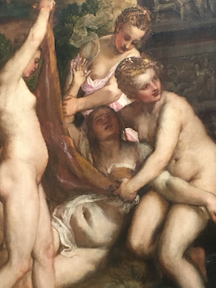
But Titian’s jaw would certainly drop if he read Nina MacLaughlin’s recent book, Wake, Siren. For the first time, he might understand the Metamorphoses from another point of view. Instead of thinking of Callisto only as the humiliated nymph, he could conceive what it feels like to be raped by a male god, disguised as Diana.
“Her tongue in my mouth, filling my mouth. No one’s tongue but mine in my mouth before that. And her hands reached up under my cloak and I don’t know if I’d had my eyes closed before but they were open now and I saw that it wasn’t Diana at all. It was Jove disguised and something pressed against my leg and the one thing he said was Don’t you scream.” (Wake, Siren, p. 28)
This contemporary literary creation, art in its own right, would challenge Titian’s assumptions. He would understand, maybe for the first time, the betrayal, disgust, imbalance of power and fear that Callisto felt. And maybe, just maybe, he would take up his brush and create a new vision of the ancient myths, from an entirely new point of view.


